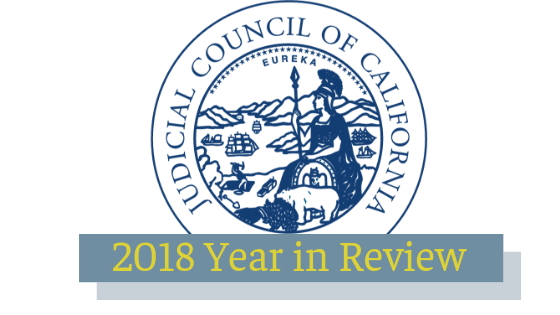
2018 Year in Review
Under the leadership of Chief Justice Tani Cantil-Sakauye and the Judicial Council, and working with the courts and justice partners, the state judicial branch was instrumental in ushering in major changes to the court system and ensuring equal access to justice for all Californians. The following are highlights of those efforts:
Replacing Money Bail With Risk Assessment
Tracking most of the recommendations made by the Chief Justice’s workgroup, Senate Bill 10 will replace the current system of money bail with one based on a defendant’s risk to the public and their likelihood to return to court. The workgroup called money bail “unsafe and unfair” because it bases a person’s liberty on financial resources rather than the likelihood of future criminal behavior. The Chief Justice also announced the creation of a new workgroup that will provide guidance on the law’s requirements and improving the pretrial process.
Courts Expand Language Access for the Public
The council continued its work to help courts serve limited-English speakers who use the courts. In addition to all criminal cases, 51 of California’s 58 trial courts now provide interpreters for critical civil cases, which include domestic violence, child custody, elder abuse and evictions. Courts also provide multilingual signage, complaint/comment forms on the language services available, and language help at clerk’s counters and court self-help centers.
Branch’s Budget Prudence and Advocacy Pay Off for Court Users
The fiscal year 2018–19 state budget included a $284 million boost in new funding to improve and modernize trial court operations and increase access for court users. The budget includes money for expanding self-help services for those without an attorney, eight online traffic court pilot projects, and 10 new courthouses. The budget represents years of advocacy by judicial officers, court leaders, council staff, attorneys, and justice system partners who stressed the need to adequately fund the court system. See more.
Supporting Court Innovation
The judicial branch continued to support court innovations and efficiencies replicable statewide. Grant funding for 50 local court projects are testing new approaches to make court more accessible and setting up new collaborative “problem-solving” courts that promote recovery and decrease repeat offenses. Those projects include a mobile app for conducting court business online, remote video conferencing, and a juvenile human trafficking court. See more.
Courts Put New Laws Into Practice
The judicial branch helped implement hundreds of new laws, including those related to parole for minors serving life sentences, recreational marijuana, gender identity, and the death penalty review process. “It takes all three branches of government to create change. Once the Legislative and Executive branches have completed their role in enacting new laws, the work shifts to the judicial branch,” said the council’s Administrative Director Martin Hoshino. See more.
Responding to Workplace Discrimination and Harassment
At the request of the Chief Justice, the council revised the rules of court to require settlement agreements involving complaints against judicial officers—including those involving sexual harassment or discrimination—be disclosed to the public. The Chief Justice also created a new council work group to study and make recommendations for how the judicial branch can better prevent and address inappropriate workplace conduct. See more.
Justice Continue Despite Wildfires
The council worked with trial courts in fire-ravaged areas on emergency order requests to extend filing deadlines in jurisdictions with courthouse closures. The council also provided smoke-affected courts with air scrubbers and indoor air quality tests to ensure the safety of courthouse occupants. Further, coordinating cases helped avoid delays and the possibility of conflicting rulings in the nearly 100 civil lawsuits filed against PG&E for its role in the fires. "In the aftermath of a disaster, the courts often become a third or fourth responder," said the Chief Justice.
Collaborating with Native American Communities
The council hosted the first annual statewide symposium for judges, attorneys, social workers, educators, and students to learn about the Indian Child Welfare Act (ICWA) and its impact on Native American communities. The council’s Tribal Court-State Court Forum develops and shares local rules of court, protocols, standing orders, and other agreements that promote tribal court–state court coordination and cooperation.
Students Learn About the Court System
The judicial branch continued work on increasing civics education in California schools and promoting lessons about the courts’ crucial role in our democracy. These efforts included the state’s new History-Social Science Framework and its greater emphasis on civics, promoting partnerships between local courts and school boards, and creating the Civic Learning Awards and Judges in the Classroom programs. This year judges met directly with educators to offer them tools for teaching their students about the judicial system.
More than 100 New Judicial Appointments
After years of highlighting the need for more judges, the courts this year welcomed more than 100 qualified and diverse appointments to the bench. The most recent judicial demographics survey of California judicial officers showed a steady increase in women and non-white justices and judges over the last 12 years.
Judicial and Attorney Ethics
The courts and the council collaborated on an update to the Judicial Conduct Handbook, which increases public trust and confidence in the court system by helping to ensure proper judicial behavior both on and off the bench. The California Supreme Court released dozens of opinions and advice on judicial ethics and approved a comprehensive revision to the attorney rules of professional conduct.
Honoring Extraordinary Contributions to the Branch
The council’s Distinguished Service Awards recognize extraordinary leadership and contributions to the justice system. Marking the 25th anniversary of the awards, the council honored a judicial leader in decriminalizing school discipline, a court executive who dedicated nearly three decades to public service, and a retired public defender who founded the nation’s first homeless court, which provides services and a way to clear criminal records.



